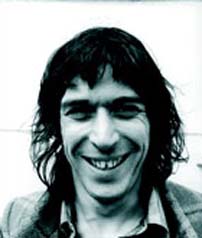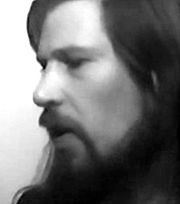Monday, December 29, 2008
Brothersport by Animal Collective
buy the record when it comes out... I already posted a different version of this but the official version kills - I am having one of those instant replay moments with it...
PS - Can anyone get me a ticket for one of the LA shows! Zoiks I slept on it...
Sunday, December 28, 2008
Friday, December 26, 2008
Wednesday, December 24, 2008
Tuesday, December 23, 2008
Monday, December 22, 2008
Sunday, December 21, 2008
Saturday, December 20, 2008
Step it up, please...
because they are stepping it up as well,
PROTEST TONIGHT...
Yes on 8 Files to Nullify Marriages;
Ken Starr Joins Team;
Jerry Brown Tells Court to
Throw it Out
Friday, December 19, 2008
it feels cold here in la...
from my friend Jesse
in NYC and suddenly
I feel warm...
Wednesday, December 17, 2008
Recent Entries
12.15.08
12.12.08
12.11.08
12.11.08
Beliayev-Guintovt Wins Kandinsky Prize; PMA Hires New Curator
12.10.08
12.10.08
Mellon Foundation Funds Curatorial Fellowship at RISD Museum
12.09.08
12.09.08
Russian Government Creates Commission to Review Soviet-Era Art Sales

Velvet Underground’s John Cale to Represent Wales at Venice
12.17.08
Velvet Underground founding member John Cale is to represent Wales at the Venice Biennale next year. The sixty-six-year-old musician will produce new audiovisual work, in collaboration with artists, filmmakers, and poets, reports the BBC. The work is said to be influenced by Cale's own personal relationship with the Welsh language and the wider issues of communication. Cale, born in Garnant, south Wales, went on to work with the likes of the Stooges, Terry Riley, Brian Eno, Happy Mondays, Modern Lovers, Manic Street Preachers, Super Furry Animals, and Patti Smith. He is best known for founding the Velvet Underground with Lou Reed after moving to New York in 1963. “As surprised and honored as I was to be asked to contribute to the Welsh presentation at the Venice Biennale of Art 2009, it also was a challenge that I eagerly accepted,” Cale said. “It offers an occasion to address certain pernicious issues in my background that had lain dormant for so long. There are certain experiences uniquely suited to the exorcism of mixed media and I am grateful for this opportunity to address them.”
Monday, December 15, 2008
George Brecht, 82, Fluxus Conceptual Artist, Is Dead
George Brecht, a core member of Fluxus, the loosely affiliated international group of playful Conceptual artists that emerged in the early 1960s, died on Dec. 5 in Cologne, Germany. He was 82 and lived in Cologne.
He died in his sleep, said Geoffrey Hendricks, a friend, who was also a Fluxus member. He had been in failing health for several years.
Mr. Brecht came of age as an artist in the late 1950s, when Abstract Expressionism and the cult of the heroic creative genius were ascendant. Inspired by the Conceptual art of Marcel Duchamp and the experimental music of John Cage, he began to imagine a more modest, slyly provocative kind of art that would focus attention on the perceptual and cognitive experience of the viewer.
American, European and Asian artists who were thinking along similar lines included Dick Higgins, Alison Knowles, Ben Vautier, Nam June Paik and George Maciunas, who in 1962 came up with the name Fluxus for this confederation of like-minded Conceptualists.
Like many other Fluxus artists, Mr. Brecht created assemblages consisting of ordinary objects in boxes and cabinets, as well as arrangements that often included chairs. He also made paintings and sculptures that played with language, like a piece with white plastic letters spelling “sign of the times.”
His most important and original contribution was a form he called the “event score,” which typically was printed on a small white card that he would mail to friends. The event score consisted of a title followed by eccentric instructions. The directive for “String Quartet,” for example, read simply, “Shaking hands.” The musicians would perform it by doing just that.
One of his most famous pieces was “Drip Music,” in which “a source of water and an empty vessel are arranged so that the water falls into the vessel.” Performances of “Drip Music” can be seen on Youtube.com.
He created event scores for sculptures as well. Instructions for “Three Arrangements,” for example, read, “on a shelf/on a clothes tree/black object white chair.”
Mr. Brecht said that he did not care if any of his event scores were realized and that he did not think that there was a correct way to perform one. He once wrote that his events were “like little enlightenments I wanted to communicate to my friends who would know what to do with them.”
Mr. Brecht was born George MacDiarmid on Aug. 27, 1926, in New York. His father, a flutist who played in the Metropolitan Opera Orchestra and the NBC Radio Orchestra, died when his son was 8. Mr. Brecht changed his last name to Brecht — not in reference to Bertolt Brecht, but because he liked the sound of the name — around 1945 while serving in the United States Army in Germany.
After the war Mr. Brecht studied chemistry at the Philadelphia College of Pharmacy and Science in Philadelphia, and he supported himself as a research chemist from 1950 to 1965.
In the mid-1950s, following the lead of Jackson Pollock, Mr. Brecht produced paintings using chance operations and materials like bed sheets, ink and marbles. In 1958-59, he attended a class in experimental music composition taught by John Cage at what was then the New School for Social Research in New York. Soon he was producing compositions even more radical than those of Mr. Cage.
In the early 1960s, Mr. Brecht taught in what was then the unusually progressive art department of Rutgers University, along with Mr. Hendricks, Allan Kaprow (who became known as an inventor of the “happening”) and Robert Watts, who also became a Fluxus artist.
Mr. Brecht’s first solo exhibition, “Toward Events: An Arrangement,” was at Reuben Gallery in New York in 1959. During the next five years, he participated in many group exhibitions and performances in New York. His work “Repository” (1961), a wall cabinet containing a pocket watch, a thermometer, rubber balls, toothbrushes and other objects, was included in “The Art of Assemblage,” the famous 1961 exhibition at the Museum of Modern Art, and the museum later bought it. Nine years later, Mr. Brecht was included in “Information,” another landmark show at the Modern.
In 1965, Mr. Brecht left New York. He lived in Rome, the South of France, London and Düsseldorf, Germany, before settling in Cologne in 1972.
He is survived by his wife, Hertha, and a son, Eric, who lives in Southern California.
Mr. Brecht’s work was especially appreciated in Europe. He was included in Documenta, the giant exhibition in Kassel, Germany, in 1972 and 1977. In 2005 the Museum Ludwig in Cologne organized a comprehensive career retrospective, which traveled to the Museum of Contemporary Art in Barcelona.
Mr. Brecht once described his art as a way of “ensuring that the details of everyday life, the random constellations of objects that surround us, stop going unnoticed.”Saturday, December 13, 2008
Milk and ... Twinkies?

On Thanksgiving, a day of mythology itself, I awoke and began the tradition of making not-so-great mushrooms stuffed with Polly o mozzarella and Ritz crackers while listening to Michael Pollan speak rather calmly about the country petitioning him to the Office of Secratary of Agriculture. Alive with my contradictions I chopped, I mixed, I stuffed. I can hardly focus in silence needing some other thing to nudge my brain into the desired direction. The Pollan rerun on NPR ended and Brian Lehrer turned his voice to something far less engaging so I turned the radio off. I thought a bit about cheap food as I crushed and sprinkled the Ritz over my cheese capped friends before the quiet in the empty apartment froze my knife mid celery like a sword in the stone.
Shuffling through Netflix discs I found the only one I hadn't watched yet was called "The Times of Harvey Milk." A gay documentary. It seems I had a moment when first learning to "flix" where I didn't quite know how to navigate their tricky suggestion boxes and ordered up two weeks worth of gay docu-dramas including such classics as Lesbians of Beunos Aires and Indiana Jones and the Kingdom of the Crystal Skull.
So on goes Harvey Milk. I had seen his name in the New York Times entertainment section and also new about the school in Manhattan named after him but aside from that I didn't know much. The opening scene is the press conference in which they announce his death and someone says "Jesus Christ" they way people do only when they experience great pain and I trade cooking for concentration. An hour later I'm sitting on the couch still clutching the spatula and, well, tearing up.
The documentary is great because Harvey Milk was great. Enigmatic and whip smart the man who came out at forty to become the first openly gay elected official encouraged every gay person to come out so as to ease the suffering of living a life in fear.
Harvey Milk and Mayor George Mescone were shot in the City Town Hall of San Francisco by Dan White on November 27, 1978. In his 11 months as City Supervisor Milk passed the first gay rights ordinance in San Francisco and among many other things made sure teachers couldn't get fired for being gay.
Dan White was Milk's conservative contemporary on the board of city supervisors. He was caught and charged with murder but got off with voluntary manslaughter and was released in five years. His defense? Depression. His proof? He ate lots of Twinkies.
There is nothing trivial in this story but there is tragic comedy. Milk was a great man and leader. Cheap food played a role in his killers defense. It seems like a stretch but it is history. But then it seems like a stretch that anyone would eat A foamy, fuzzy, sickly sweet Hostess. David White killed himself a few years after being released from prison.
In one of the most heartbreaking moments in the film is a blurry eyed friend speaking of Harvey Milk asking all gay people to come out. He ends by looking into the camera and saying in a way that makes you feel as though he is standing in front of you, "Imagine how many more people would have lived through AIDS if Harvey Milk was still alive."
Thursday, December 11, 2008
Wednesday, December 10, 2008
Saturday, December 6, 2008
showwwwsssss
Varda Caivano, Matt Connors,Thomas Hylander, Zak Prekop Exhibition Dates: December 13 - January 31, 2009 | |||

































